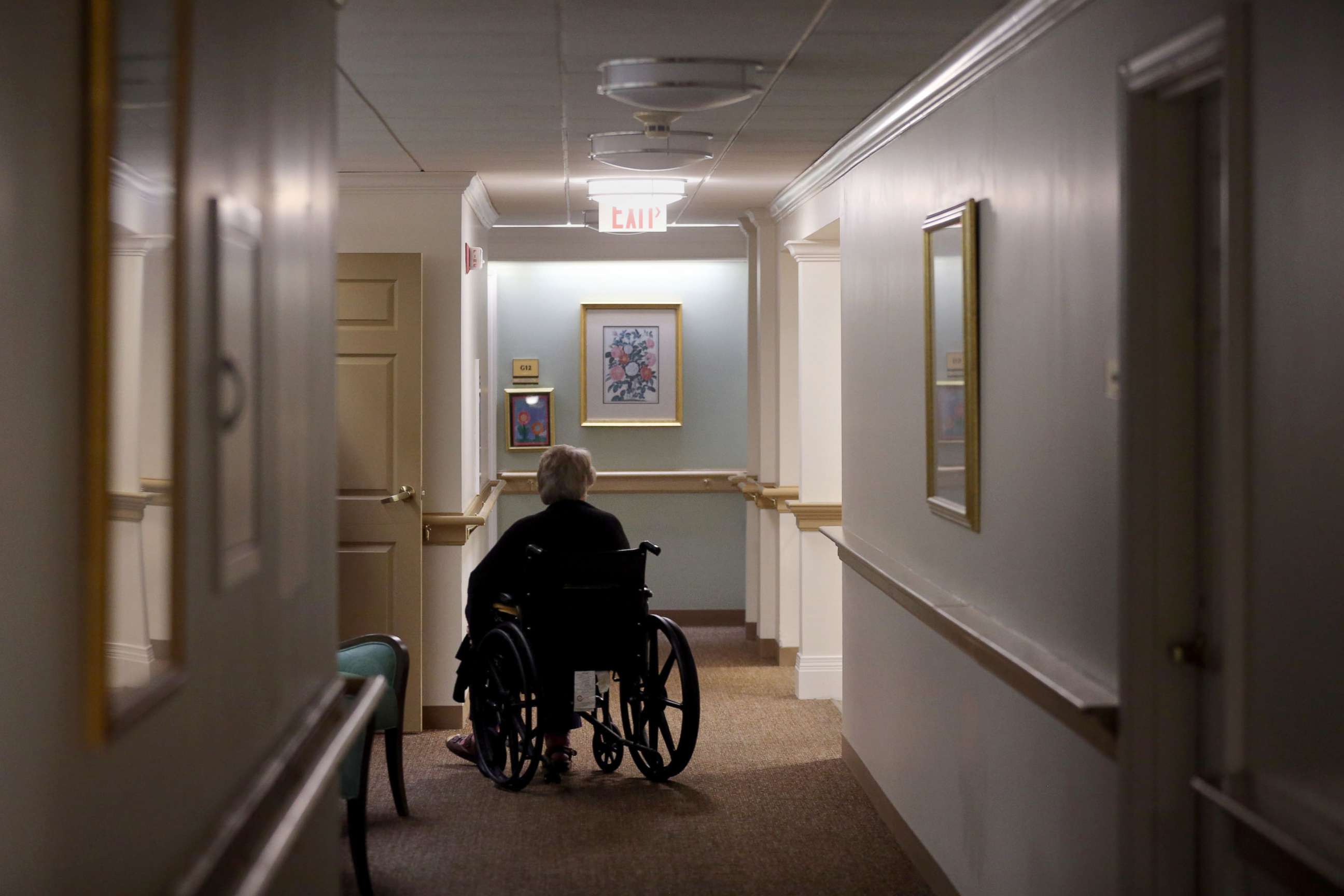Facing labor shortages and cost hikes, many long-term care facilities are shuttering
Advocates say things will worsen when federal assistance expires in July.
In the sun-baked 66 miles between Tucson and Nogales at the Arizona-Mexico border, there's only one place that's able to provide the intensive, hands-on care so many patients need after they leave the hospital: Santa Rita Nursing and Rehabilitation Center.
But since the COVID-19 pandemic hit, providing that kind of care has been an uphill battle, Amy Malkin, the facility's operations chief, told ABC News. Since March 2020, Santa Rita has faced a staffing exodus as scores of employees have gotten sick, burned out, or left to care for their kids or other family members.
Now, as inflation has put the squeeze on staffers' commuting costs, that exodus has only intensified, Malkin told ABC News.
To fill the vacancies, the facility has had to rely on staffing agencies that charge several times more per worker than what they'd been previously paying -- all while insurers' reimbursement rates have remained all but fixed.
Accordingly, Santa Rita is "losing money every month," Malkin told ABC News -- forcing the facility into a vicious cycle of cost-cutting that prevents it from hiring the staff it sorely needs.
"We don't make profits anymore," Malkin told ABC News. "It's just not sustainable."
The result: For months, Santa Rita has been forced to turn patients away -- leaving them to travel miles away to find the care they need.
Santa Rita is among hundreds of long-term care facilities nationwide -- from large chains to mom-and-pop operations -- that are fighting for their survival. Many are being forced to close their doors, while others are having to turn patients away in order to survive.
According to the American Health Care Association and National Center for Assisted Living (AHCA/NCAL), which represents more than 14,000 long-term care facilities, more than 75% of operators had to limit admissions in 2021. And more than 300 nursing homes have closed since the pandemic began.

Officials say hundreds more facilities are expected to close this year -- and if the federal government's COVID-19 emergency funding expires in July, advocates say, the situation will only get worse.
AHCA/NCAL calls the current staffing shortages "historic." The long-term care industry overall was already expected to face shortages of millions of workers before the pandemic, according to PHI National, a nonprofit research organization. And according to the Service Employees International Union (SEIU), over 400,000 workers -- nearly 10% of the workforce -- left the long-term care industry between March 2020 and January 2022.
"It won't be long until the system is overrun," April Verrett, president of SEIU 2015, which represents over 400,000 workers in California, told ABC News. "We're running out of time."
The human face of shortages
For Fernanda Carley, the staffing shortages aren't just an abstract number.
Carley, who is Nogales-born and raised, is a certified nursing assistant at Arroyo Gardens, the sister facility to Santa Rita. She long aspired to be a caregiver; at 16, Carley was already taking classes on medical terminology.
But the pandemic tested that calling -- and recent months have only pushed Carley further toward the brink. As spring turns to summer, her electricity bill is way up, and gas is costing her upwards of $150 per week. To pay her bills, she's had to pick up side hustles washing cars.
All the while, she has watched countless colleagues leave for less strenuous, safer and higher-paying jobs at retailers like Amazon, Walmart and Target.
"I've been doing a lot of life contemplating," she told ABC News. In the coming months, she plans to leave her job and return to nursing school.
If and when that happens, "my hope is other great caregivers get hired," Carley said.
But, she said, "at this point, I don't see the end of the pandemic or the inflation -- and I don't think either helps the situation. I don't know when people would be willing to work in this industry anymore."
The high cost of shortages
Like Santa Rita, many long-term care providers are combatting the workforce shortage by relying on staffing agencies to fill their vacancies.
"Provider organizations are left with few options to ensure they have the staff needed," said Colleen Knudsen, a spokesperson for LeadingAge, an association of nonprofit aging services providers.
But that approach comes with its own consequences. Labor is the main line-item for long-term facilities, accounting for about 70% of expenses, Christina Crawford, spokesperson for AHCA/NCAL, said in a statement. And agencies are charging two to three times more than pre-pandemic staff rates, according to AHCA/NCAL.
For many facilities, those costs are wholly unaffordable.

Aria Healthcare, which operates three facilities in Wisconsin, simply will not hire agency providers. According to their calculations, in order to fully staff a unit with agency providers, they'd need to keep more beds completely full with patients all day, every day, than is possible based on the number of admissions they get.
"The math just doesn't work out," Aneillo Lindsay, Aria's chief innovation officer, told ABC News.
Similar patterns are playing out across the country.
In Florida, long-term care facilities' use of employment agencies is up by nearly 300%, according to the Florida Health Care Association. Facilities have seen an increase of $275 million annually in staffing costs resulting from paying overtime, contract labor, and other costs associated with hiring additional in-house staff, Kristen Knapp, spokesperson for FHCA, told ABC News.
And yet, the median pay for certified nursing assistants in 2020 was $14.82 an hour, according to the Bureau of Labor Statistics.
Robert Oronia, a certified nursing assistant in Los Angeles, says that's not enough. And while Oronia says some of his colleagues have seen raises after shifting to agency work, those raises often come at the cost of benefits.
Marginally higher wages, in the absence of benefits, are still "un-liveable," Oronia told ABC News.
"It's just one vicious, vicious cycle that's going on now," he said. "People are just getting tired of it -- they don't want to do this work."
Forced closures
All this financial strain has taken a toll on facilities across the country. Some, like Aria in Wisconsin, have stayed open at a reduced capacity. During the pandemic, Aria was forced to leave over 100 beds across its facilities empty, Lindsay told ABC News.
Others have been forced to close entirely.
According to a recent AHA/NCAL report, the more than 300 nursing homes that have closed during the pandemic have displaced nearly 13,000 patients.
An additional 400 facilities are projected to close in 2022.
"Ultimately, these staffing and economic challenges are resulting in limited access to care for our nation's seniors," Crawford, with AHCA/NCAL, told ABC News.
The situation will likely get worse when Medicare reimbursement rates drop upon expiration of the public health emergency declaration by the Department of Health and Human Services. The emergency declaration is scheduled for expiration on July 15.
The resulting 5% funding loss would put another one-third of long-term care facilities at risk of closing, according to a recent audit by CliftonLarsonAllen, a financial advisory firm. That could leave up to 417,000 patients and families scrambling to find the care they need.
"The financial pressures are just too much," Malkin, in Arizona, said. "Places are going to close ... places are definitely going to close."
But so far, Santa Rita and Arroyo Gardens are braving the storm, Malkin told ABC News.
"For now," she said.



